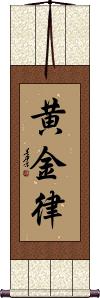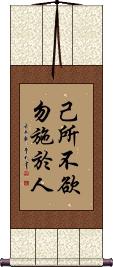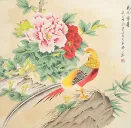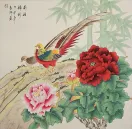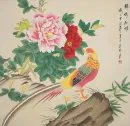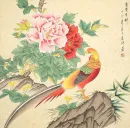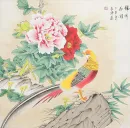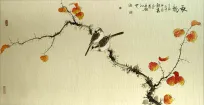Many custom options...
And formats...

Not what you want?
Try other similar-meaning words, fewer words, or just one word.
Feel free to email me with your request. If it's easy, I'll translate it for free and add it to this database of calligraphy for you.
Golden Rule in Chinese / Japanese...
Buy a Golden Rule calligraphy wall scroll here!
Personalize your custom “Golden Rule” project by clicking the button next to your favorite “Golden Rule” title below...
Golden Rule
Confucius: Golden Rule / Ethic of Reciprocity
Do not do to others what you do not want done to yourself
Some may think of this as a “Christian trait,” but actually, it transcends many religions.
This Chinese teaching dates back to about 2,500 years ago in China. Confucius had always taught the belief in being benevolent (ren), but this idea was hard to grasp for some of his students, as benevolence could be kind-heartedness or an essence of humanity itself.
When answering Zhong Gong's question as to what "ren" actually meant, Confucius said:
己所不欲勿施于人 or "When you go out, you should behave as if you were in the presence of a distinguished guest; when people do favors for you, act as if a great sacrifice was made for you. Whatever you wouldn't like done to you, do not do that thing to others. Don't complain at work or home.”
Hearing this, Zhong Gong said humbly, “Although I am not clever, I will do what you say.”
From this encounter, the Chinese version of the “Golden Rule” or “Ethic of Reciprocity” came to be.
The characters you see above express, “Do not do to others whatever you do not want to be done to yourself.”
See Also: Confucius Teachings | Benevolence
This in-stock artwork might be what you are looking for, and ships right away...
Gallery Price: $268.00
Your Price: $148.88
Gallery Price: $63.00
Your Price: $35.00
Gallery Price: $268.00
Your Price: $148.88
Gallery Price: $65.00
Your Price: $35.88
Gallery Price: $268.00
Your Price: $148.88
Chinese Golden/Red Butterfly & Flower Painting
Discounted Blemished
Gallery Price: $53.00
Your Price: $29.00
Gallery Price: $65.00
Your Price: $35.88
Gallery Price: $268.00
Your Price: $148.88
Gallery Price: $72.00
Your Price: $39.88
Gallery Price: $220.00
Your Price: $138.88
Gallery Price: $60.00
Your Price: $39.88
Not the results for golden rule that you were looking for?
Below are some entries from our dictionary that may match your golden rule search...
| Characters If shown, 2nd row is Simp. Chinese |
Pronunciation Romanization |
Simple Dictionary Definition |
黄金律 see styles |
ougonritsu / ogonritsu おうごんりつ |
More info & calligraphy: Golden Rule |
金科玉律 see styles |
jīn kē yù lǜ jin1 ke1 yu4 lu:4 chin k`o yü lü chin ko yü lü |
golden rule; key principle |
金科玉条 see styles |
kinkagyokujou / kinkagyokujo きんかぎょくじょう |
(yoji) (See 黄金律) golden rule (basic principle ensuring success in some activity) |
ゴールデンルール see styles |
goorudenruuru / goorudenruru ゴールデンルール |
golden rule |
ゴールデン・ルール |
gooruden ruuru / gooruden ruru ゴールデン・ルール |
golden rule |
Variations: |
goorudenruuru; gooruden ruuru / goorudenruru; gooruden ruru ゴールデンルール; ゴールデン・ルール |
golden rule |
The following table may be helpful for those studying Chinese or Japanese...
| Title | Characters | Romaji (Romanized Japanese) | Various forms of Romanized Chinese | |
| Golden Rule | 黄金律 | ougonritsu / ogonritsu | ||
| Confucius: Golden Rule Ethic of Reciprocity | 己所不欲勿施於人 己所不欲勿施于人 | jǐ suǒ bú yù wù shī yú rén ji3 suo3 bu2 yu4, wu4 shi1 yu2 ren2 ji suo bu yu, wu shi yu ren jisuobuyu,wushiyuren | chi so pu yü, wu shih yü jen chisopuyü,wushihyüjen |
|
| In some entries above you will see that characters have different versions above and below a line. In these cases, the characters above the line are Traditional Chinese, while the ones below are Simplified Chinese. | ||||
Successful Chinese Character and Japanese Kanji calligraphy searches within the last few hours...
